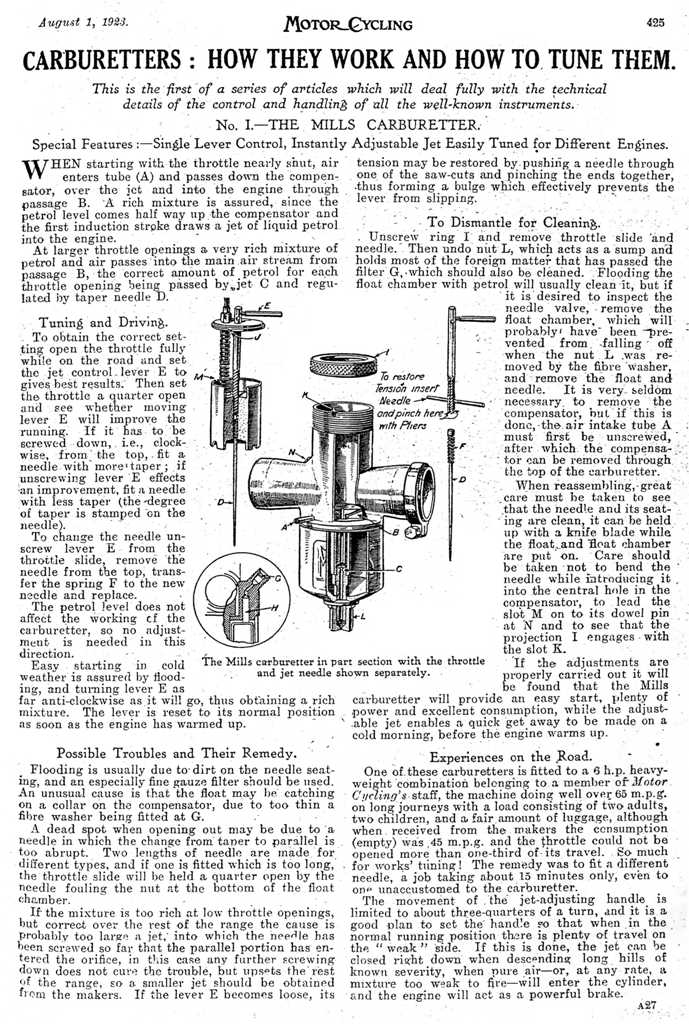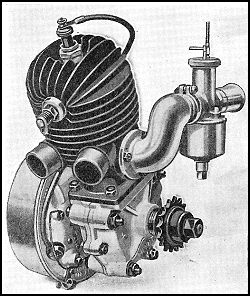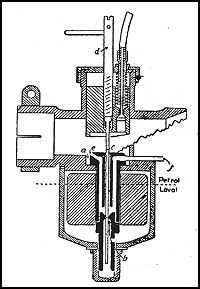STEWART MODEL "25" CARBURETOR USED ON DODGE BROS. CAR
This carburetor is a metering valve, expanding type. The air and fuel are both metered by a combination of the metering valve and metering pin.
It is located on the left-hand side of the engine and is fed from the vacuum tank on the engine.
Construction
Float chamber: Fuel enters the carburetor at (A), passing up through the strainer (B), into the float chamber (C), through the needle valve (D). The valve (D) is actuated by means of the float (E), operating through the counterweight levers (F).
As the fuel flows into the float chamber the float rises and, acting against the levers (F) forces the needle valve down and closes same.
As the float rises the valve closes until the float reaches a certain predetermined level at which the valve is entirely closed.
1 From instruction books of Stewart carburetor issued by the Detroit Lubricator Co., Detroit, -Mlich. (manufacturers).
If the float falls below this level, because of the diminishing supply of fuel in the float chamber, the valve is automatically opened and more fuel is admitted to bring the level up to correct height.
From the above it will be seen that the float chamber constitutes a reservoir of constant supply, in which the height of fuel is always at the same level. This contributes to efficient metering.
Dashpot chamber: From the float chamber the fuel flows through passage (G) into the dashpot chamber (H). It also passes through the holes (I) in the valve piston into the central space (J) which surrounds the tapered metering pin (W).
The metering valve has a piston (L) at its lower end and which operates in the dashpot chamber.
The object of the dashpot is to improve the performance of the carburetor by steadying the action of the metering valve during acceleration and low speed operation of the engine.
Name of Parts
A, fuel supply inlet; B, strainer; C, float chamber; D, gasoline needle valve; E, float; F, counterweight levers; G, gasoline passage; H, dashpot chamber; I, gasoline passage; J, gasoline passage; K, dash adjustment lever; L, riashpnt piston; M, metering valve head; N, metering valve stem; 0, as-pirating tube or nozzle; P, primary air passage; Q, metering valve seat; R, mixing chamber; S, fuel metering orifice; T, metering pin rack carrier; U, adjustment lever clamp screw ; V, adjustment screw; W, metering pill; X, gear housing; Y, pinion shaft; Z, low throttle stop screw; AA, strainer plug; BB, air inlet; CC, throttle valve.
The metering valve consists of a conical shaped head (M), CC stem (N), and piston (L). This is the only moving part in the carburetor proper. It slides up and clown in its guide, formed in the body of the carburetor. The upper part of this valve contains a jet or nozzle (0) and primary air openings (P).
When the engine is at rest, the conical head of the metering valve seats in the carburetor body at (Q). When the engine is running, however, the metering valve is always floating in some higher position, thereby forming an annular or ring-shaped air opening between_the conical head and its seat (Q).
Fig. 1. Stewart model "25" carburetor, 1" size, with rack and pinion dash adjustment used on Dodge Bros. car. Side, or horizontal outlet.
1261
Action of Carburetor
The action of the carburetor is as follows: The suction created by the down-ward stroke of the engine pistons draws air into the mixing chamber (R) through the primary air openings (P). The same suction draws a fine spray of atomized fuel from the nozzle (0) into the mixing chamber. The air thus mixing with the fuel forms a combustible gas for the engine. As soon as the engine begins to rotate, the metering valve lifts sufficiently to allow the main air supply to pass into the mixing chamber between the conical A head (M) and the seat (Q).
Fuel is metered in an annular shaped orifice near the center of the valve at (S) passing between the valve and the tapered A A portion of the stationary metering pin (W). As the metering valve lifts into the higher positions, it gives increasingly larger fuel openings due to the lifting of the valve away from the tapered metering pin, also larger air openings due to the





 Reply With Quote
Reply With Quote


 .
.








Bookmarks